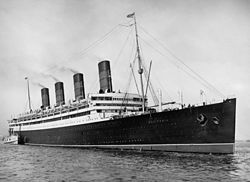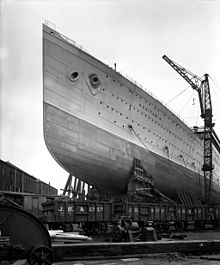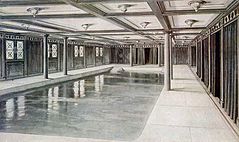RMS Aquitania
|
||||||||||||||||||||||
|
||||||||||||||||||||||
|
||||||||||||||||||||||
|
||||||||||||||||||||||
The RMS Aquitania was a 1914 of completed passenger steamer of the Cunard Line for the transatlantic - regular service between the UK and the USA . Due to her exceptionally long service life, which included both World Wars, she is still one of the most famous Atlantic liners and was the last four chimney steamer in existence from 1935 until it was scrapped in 1950. Built as a response of the Cunard Line to the Olympic class of the competing White Star Line , the Aquitania was one of the most popular and economically successful transatlantic liners , especially in the 1920s and 1930s . In the English-speaking world, it was because of their noble features and elegant lines as "The Ship Beautiful" ( dt .: "The beautiful ship" hereinafter).
Origin and construction
With the completion of the two sister ships Mauretania and Lusitania in 1907, the Cunard shipping company had achieved an undisputed top position in transatlantic passenger traffic. In the years that followed, significantly larger ships were built for competing domestic and foreign shipping lines (e.g. the Olympic of the White Star Line or the Imperator class of the German HAPAG ), but the combination of unmatched high speed, luxurious equipment and the The fact that Cunard had two complementary express steamers gave the line a certain head start. Nevertheless, both ships were gradually in danger of falling behind in view of the size development in passenger shipbuilding, with which more and more amenities were connected in the design of the rooms. Cunard therefore decided to order a third ship for the liner service to complement the two sister ships, which should not be as fast as Mauretania and Lusitania , but set new standards in British passenger shipbuilding in terms of dimensions and equipment.
On December 8, 1910, the construction contract for the new express steamer was awarded to the John Brown & Company shipyard in Clydebank , which had already built the Lusitania . Cunard's leading shipbuilder, Leonard Peskett, was responsible for the design of the new ship, and he had earned an excellent reputation with the designs for Mauretania and Lusitania . A month and a half later, the name Aquitania was determined for the steamer to be built , which - in accordance with the traditions of the Cunard shipping company - ended with "-ia" and thus also recalled the naming of its future "shipmates", who were also named after historical regions. Despite this similarity of names, Aquitania on the one hand and Mauretania and Lusitania on the other hand were not sister ships .
In June 1911 the keel of the Aquitania was laid and on April 21, 1913 the 22,000 ton hull of the ship was launched after it had been christened by the Countess von Derby . By May 10, 1914 the equipment and interior fittings of the ship took place.
Design and interior
The aim was to achieve a completely new quality of equipment for British passenger ships with the Aquitania . In particular, the Olympic of the White Star Line was considered to be the benchmark to be surpassed. Originally, this should not only be achieved in the area of interior design, but also in terms of the size of the ship, but the Aquitania did not achieve the desired 47,000 GRT: with only around 45,600 GRT, she lagged behind the Olympic , which after a renovation in 1913 was around 46,300 GRT was great. Nevertheless, the Aquitania was the first British ship with a length of more than 900 feet (274 meters) and could therefore at least claim the title of "Longest British Ship".
The floor plan was similar in its basics to that of Mauretania and Lusitania , but the enormous increase in size of the Aquitania enabled a significantly expanded space with a variety of additions that significantly increased the comfort of the ship for the passengers .
First class
The first class on board the Aquitania had a large number of lavishly furnished and spacious rooms. On the A-deck of the ship there was a reading and writing salon , the foyer of the large staircase, two gallery rooms that functioned as additional salons, a magnificent lounge with a raised ceiling, white and gold stucco and ornate ceiling paintings, which are around 45 meters long " Large gallery ”of the ship, in which - for the first time on a passenger ship - jewelry objects and works of art were exhibited in lavishly designed showcases and wall cupboards, as well as a smoking room paneled with dark wood. So-called “garden lounges” were located on both sides of the lounge on the promenade running around the deck; Terrace cafés equipped with wicker furniture, half-timbering and wall planting. On the D-deck of the ship was the two-deck high dining room, which was in the style of Louis XVI. was decorated in white, gold and pastel tones . In addition to the dining room, there was also a “grill room” in the Jacobean style, in which, for a surcharge, you could have your meals in a somewhat more private atmosphere than in the large dining room. In contrast to the competing ships of HAPAG and the White Star Line, the grill room was not a separate restaurant with a separate à la carte menu. Such an offer did not correspond to the traditions of the Cunard Line until the early 1930s. One deck below was a swimming pool with an adjoining sports and gymnastics room. The most expensive accommodations on the ship were eight suites on the B-deck, which were named after famous artists; The largest of these were the Gainsborough and Reynolds suites, each with its own vestibule , living room, private veranda, two bathrooms with toilet and three bedrooms.
An essential aspect, especially in the design of the cabins, but also in some public spaces (such as the dining room or the reading and writing room) was the extensive renunciation of embellishments, splendid carving and stucco work and decorative objects. On the Aquitania , clear shapes and flat surfaces predominated, which created a rather simple elegance. This formed a significant contrast to the rather cluttered design of other contemporary ships (see web link) .
Second grade
The equipment of the second class on board the Aquitania corresponded in quality and size to the rooms of the first class on other contemporary ships. In addition to an exceptionally large dining room, which was also two decks high, there was a reading and writing salon, a lounge, a smoking salon and its own veranda café. All these rooms were artistically executed in different style periods and furnished with expensive furniture.
Third grade
Even before the First World War, it was designed as an inexpensive, comparatively spartan emigrant class, but the third class of the Aquitania was converted into a tourist class in the 1920s and its furnishings were upgraded accordingly. Spacious multi-bed cabins, a spacious dining room, several public rooms and roofed promenade decks offered the passengers a balanced price-performance ratio.
Machine system
The Aquitania was equipped with a total of six turbines , four of which were intended for forward thrust and two for reverse thrust. One turbine each drove a propeller, the two turbines for reversing were connected to the two inner propellers. This system developed a total of around 56,000 hp standard, but was actually able to achieve over 60,000 hp. The ship reached average speeds of around 23 to 24 knots and was characterized by its extremely smooth running and the absence of noticeable vibrations; a problem that was found uncomfortable on many other ships of the time. According to the Aquitania's chief engineer , George Patterson, the reason for this was the exceptionally successful synchronization of the four turbines and thus the revolutions of the ship's propellers.
Before the First World War, it was still heated by coal firing. After the overhaul in 1919/20, the ship's boiler system was converted to the much more economical and efficient oil operation.
Mission history
Before the First World War
The Aquitania completed its test drives in the Firth of Clyde in early May 1914 and fulfilled all expectations. On her maiden voyage from May 30 to June 5, 1914 from Liverpool to New York, she reached an average speed of 23 knots. On the return voyage, she carried 2,649 passengers, more than ever before on a British ship on this route. After only three round trips, however, after the outbreak of the First World War, she was drafted into military service and converted into an armed auxiliary cruiser .
In the first World War
After being armed with the usual armament for auxiliary cruisers, she went on patrol from August 8, 1914. In the same year she collided with the Leyland liner Canadien and was damaged so that she had to return to Liverpool for repairs. During the stay in the shipyard, the Admiralty decided to launch the Aquitania together with the Mauretania , because the military found it too easily vulnerable due to its size. The armament has been removed.
The layover lasted until May 1915, when it was used as a troop transport for Operation Gallipoli . In four months she shipped 30,000 soldiers , her size and speed being extremely useful for this type of use. After the operation failed in August, it was converted into a hospital ship. For this purpose, the large common rooms on the upper decks were converted into hospital wards. After a short shipyard period in mid-1916, it continued to serve as a floating hospital until the end of the year, but was then launched for the entire following year.
In 1918 she was used again as a troop transport and brought American troops across the Atlantic to Europe . During this time she drove in camouflage. On October 9, 1918, she collided with the US destroyer USS Shaw off the Irish coast . Twelve people were killed on the destroyer. The Aquitania reached the port of Southampton safely with 8,000 soldiers on board.
After the First World War
After the peace agreement, the Aquitania brought American and Canadian troops back home and returned to commercial service with the first departure from Southampton on June 28, 1920. A thorough overhaul in a shipyard on the Tyne was followed by the liner service to New York together with the two Cunard liners RMS Mauretania and RMS Berengaria . Two departures per week could be offered with the three ships. In winter she went on cruises if necessary .
Between the Great Depression and World War II
The depression after the Great Depression hit passenger shipping so hard that the Mauretania was taken out of service and sent on a cruise. The merger of the Cunard Line with the White Star Line in 1934 added two more ships, the Majestic and the Olympic . During this time the Aquitania ran in the Solent , the waterway between the Engl. South coast and the Isle of Wight , twice aground, one of which was 26 hours, but suffered no serious damage.
In 1936, the new Queen Mary building started up again after the Majestic , Olympic and Mauretania had been decommissioned in previous years . The original intention was to replace the Aquitania with the second Cunard Queen Elizabeth , but the outbreak of war prevented this.
In World War II
It was needed again as a troop transport. First she brought Canadian soldiers to Great Britain, in March 1940 she was sent to Sydney to bring Australian troops to the Middle East. Then she drove British soldiers to Ceylon in the WS 1 convoy . On November 25, 1941, she took on the survivors of the German auxiliary cruiser Kormoran , which had sunk the Australian light cruiser Sydney six days earlier . During the following years, the soldier transports took the ship to Rio de Janeiro , Cape Town , Fremantle , Sues , Aden and Wellington . During the shipyard overhaul in New York, two 6-inch and several smaller guns were installed.
In 1942, the Aquitania was used to bring evacuated Americans from Hawaii to California after the attack on Pearl Harbor .
After the Second World War
In 1946 she hosted the Foreign Ministers' Conference of the four victorious powers America, Great Britain, France and the Soviet Union in New York. Towards the end of 1947 she was sent to Australia with emigrants, and in March 1948 she started a regular emigration service to Canada.
During the previous stay in the shipyard, space was created on board for an additional 1,700 passengers. Because of the poor equipment this was called the "Spartan class". The old age finally brought the end for the Aquitania, she was sold for scrapping after the end of the last voyage in December 1949.
Others
The Aquitania holds 903 Atlantic crossings 3rd place after the Queen Elizabeth 2 (1050) and the Queen Mary (1001).
literature
- Robert D. Ballard , Rick Archbold: Lost Liners. From the Titanic to the Andrea Doria. Glory and decline of the great luxury liners. Translated into German by Helmut Gerstberger. Wilhelm Heyne, Munich 1997, ISBN 3-453-12905-9 (Original edition: Lost liners. From the Titanic to the Andrea Doria. The ocean floor reveals its greatest lost ships. Hyperion, New York NY 1997, ISBN 0-7868-6296 -3 ).
Web links
- Web presence of the Aquitania Historical Society with many pictures, videos and information about Aquitania ( Memento from July 18, 2011 in the Internet Archive ) (English)
- Facsimile of a Cunard brochure of Aquitania with many pictures (English)
- Bedroom of a suite on board the Aquitania (the extraordinary simplicity of the furnishings of the private rooms is easy to understand here)








